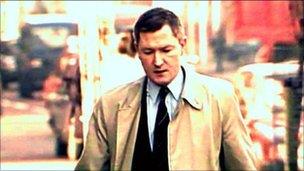Timeline of Pat Finucane murder probe
- Published
The killing of Belfast solicitor Pat Finucane by loyalist paramilitary group, the UDA/UFF remains one of the most controversial murders during the Troubles. BBC News Online looks at some of the key events in the family's quest for a public inquiry.
12 February 1989

Pat Finucane represented some high profile republicans
Mr Finucane was shot 14 times as he sat eating a Sunday meal at home, with his wife and three children. His wife was wounded in the attack.
In its statement claiming the killing, the UFF said they had killed "Pat Finucane, the IRA officer".
While Mr Finucane had represented IRA members, the family vehemently denied the allegation - and have been supported in this by the police.
April 1998
The government rejects a call by the UN for an independent inquiry.
April 1999
Sir John Stevens, then deputy commissioner of the Metropolitan Police, is appointed to carry out an investigation into the lawyer's murder.
June 1999
Former UDA quartermaster William Stobie is charged with the murder of Mr Finucane.
2000
Amnesty International calls on the then Secretary of State, Peter Mandelson to open a public inquiry into events surrounding Mr Fincune's death.
November 2001
Stobie, who admitted supplying the guns used in the killing but denied murder, walks free from court after the case against him collapses as a key witness refuses to give evidence.
December 2001
Two months later Stobie was shot dead by loyalist gunmen.
2001
Retired Canadian Judge Peter Cory appointed by British and Irish governments to investigate allegations of collusion by the RUC, British Army and Irish Police into several killing during the Troubles, including Pat Finucane.
April 2003
A report by the Metropolitan Police Commissioner Sir John Stevens, is published.
"Stevens Three" states that rogue elements within the police and army in Northern Ireland helped loyalist paramilitaries to murder Catholics in the late 1980s.
The Finucane family reiterates its call for a full, independent, public inquiry.
May 2003
Loyalist Ken Barrett is arrested and charged with the murder of Mr Finucane.
April 2004
Judge Cory concludes that military and police intelligence knew of the murder plot but failed to intervene. He recommends a public inquiry. The government refuses until the criminal proceedings against Barrett are completed.
September 2004
Barrett, who confessed in court to murdering Pat Finucane, is sentenced to 22 years' imprisonment.
September 2004
Northern Ireland Secretary Paul Murphy announces an inquiry. He said it would be necessary to hold the inquiry on the basis of new legislation to be introduced.
2005
Inquiries Act 2005 introduced and led to the creation of Hamill, Nelson and Wright inquiries. However the Finucane family opposed the new law, fearing it would enable the government to interfere with the independence of any future inquiry because it enabled a British government minister to rule when an inquiry sits in public or private.
Autumn 2006
Plans to set up an inquiry into the murder of Mr Finucane are halted by the then Secretary of State Peter Hain.
November 2010
Secretary of State Owen Paterson said he would decide in the new year whether there should be a public inquiry into the murder of Pat Finucane.
11 October 2011
The British government rules out an inquiry into Mr Finucane's murder but puts forward a proposal for a leading QC to review the case.
His family, who were told the news during a meeting with David Cameron in Downing Street, said they would continue their campaign for an independent public inquiry and would not participate in the review.
- Published13 May 2011